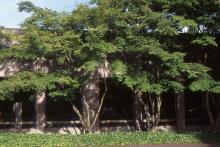Acer palmatum
Common name:
Japanese Maple
Pronunciation:
A-ser pal-MAY-tum
Family:
Sapindaceae, Aceraceae
Genus:
Type:
Broadleaf
Native to (or naturalized in) Oregon:
No
- Broadleaf deciduous tree or shrub, 15-25 ft (4.5-7.6 m), multi-trunked, variable forms, twigs glabrous, thin, bright red. Leaves simple, opposite, 5-13 cm long, 5-7(9) deeply cut lobes, lobes are lance- ovate to lance-oblong in shape, doubly serrate, fresh green above but color varies with cultivar, underside pubescent at the vein axils; fall color scarlet, orange or yellow. Flowers small, red to purple, appear along with new leaves. Fruit (samara) 1.3-2 cm long, spread at obtuse angle, much incurved, ripen in early fall.
- Sun to part shade, well-drained soil; protect from winds. "Grafted garden varieties are popular, but common seedlings have uncommon grace and usefulness: they are more rugged, faster growing, more drought tolerant, and they stand more sun and wind than named forms do (Sunsest Western Garden Book, 2007, p.168).
- Hardy to USDA Zone 5 Native to Japan, China, Korea; long cultivated in Japan. Introduced into England in 1820 and available from a California nursery by 1854.
- Jacobson (1996) states that "no tree species has been more variable in cultivation". Acer palmatum show diverse form in both leaf (especially color and degree of dissection) and plant habit (from prostrate shrubs to tree form). Because of the large number of named cultivars within the species, there have been several attempts to categorize them into several groups. For more details see, Huxley (1992), Vertrees (1978 or 1987), or van Gelderen, de Jong, and Oterdoom (1994).
- Often used in bonsai
- palmatum: lobed like a hand with fully outspread fingers
- Oregon State Univ. campus: west of arch at Ag. and Life Sciences; the west side of Weniger.











